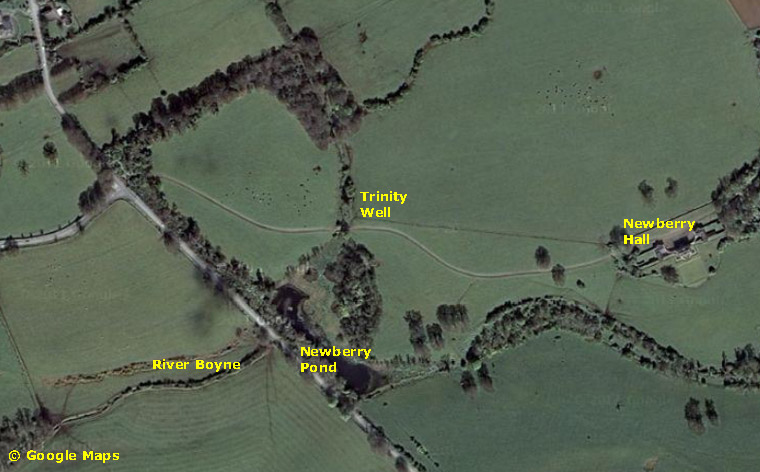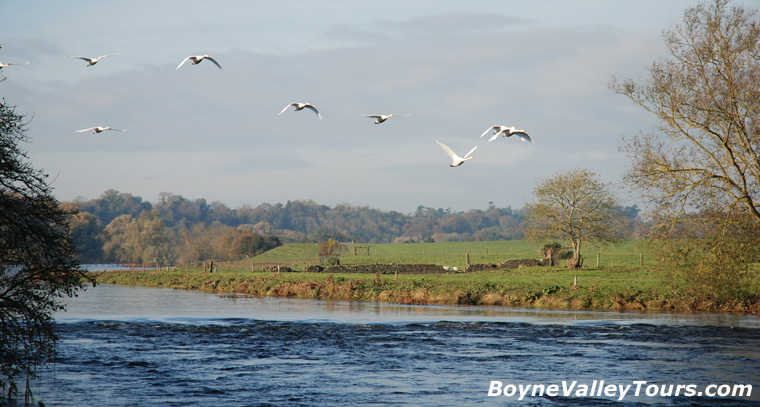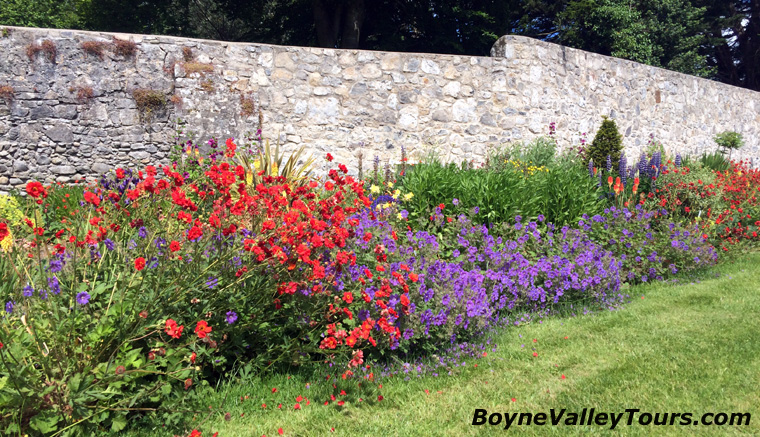The River Boyne
 The Boyne
is a river in the east of Ireland, the course of which is about 112 kilometres (70 miles) long. It rises at Trinity Well, Newberry Hall, near Carbury, County Kildare, and flows
northeast through County Meath to reach the Irish Sea between Mornington, County Meath and Baltray, County Louth.
The Boyne
is a river in the east of Ireland, the course of which is about 112 kilometres (70 miles) long. It rises at Trinity Well, Newberry Hall, near Carbury, County Kildare, and flows
northeast through County Meath to reach the Irish Sea between Mornington, County Meath and Baltray, County Louth.
Salmon and trout can be caught in the river, which is surrounded by the Boyne Valley. It is crossed just west of Drogheda by the Boyne River Bridge that carries the M1 motorway and by the Boyne Viaduct that carries the Dublin-Belfast railway line to the east.
The River Boyne has a rich historical, archaeological and mythical heritage. The Battle of the Boyne, a major battle in Irish history, took place along the Boyne near Drogheda in 1690 during the Williamite war in Ireland. It passes Trim Castle, the Hill of Tara (the ancient capital of the High King of Ireland), Navan, Ardmulchan, the Hill of Slane, the ancient temples at Newgrange, Knowth and Dowth, Mellifont Abbey, and the medieval city of Drogheda. In the Boyne Valley can also be found other historical and archaeological monuments, like Loughcrew, Kells, Celtic crosses, castles and more.
This river has been known since ancient times. The Greek geographer Ptolemy drew a map of Ireland in the 2nd century which included the Boyne, which he called Bououinda, and somewhat later Giraldus Cambrensis called it Boandus. In Irish mythology it is said that the river was created by the queen and goddess Boann. In other legend the Boyne was in river where Fionn mac Cumhail captured the Salmon of Knowledge.
The Boyne Navigation is a series of canals running roughly parallel to the main river from Oldbridge near Drogheda to Navan. Owned by An Taisce and mostly derelict, the Inland Waterways Association of Ireland are restoring the navigation to navigable status. The canal at Oldbridge which runs through the Battle of the Boyne Site was the first to be restored.
Boyne River Source
The River Boyne is said to rise from Trinity Well in the grounds of Newberry Hall near Carbury, County Kildare. However the stream which flows into Newberry Pond doesn't flow from the well, it flows past the well from the surrounding fields. Carbury Hall and the 400 acre estate was sold in 2010 and there is currently no public access to Trinity Well.
Fishing
The River Boyne is renowned for its exceptional Brown Trout fishing, although it also experiences a notable run of Salmon and Sea Trout, particularly during the summer months.Salmon
The prime Salmon fishing locations are situated in the lower part of the river, stretching between Drogheda and Navan. While Salmon can also be found in lesser numbers upstream of Navan, specifically at Bective and Trim.The Salmon run typically commences in early March and continues until the end of May, with the primary fishing efforts concentrated around Navan and downstream towards Slane. In the past, the river used to witness a substantial run of large winter fish weighing between 20 and 30 pounds, but this has diminished in recent years, and most spring fish now average around 10 pounds. Notable spring fishing spots include The Ramparts and Sophie's Island.
The Grilse (Salmon returning to fresh water after a single winter at sea) start their run in July and persist through the end of August. The best Grilse fishing areas are from Oldbridge upstream to Slane, with Oldbridge, Staleen, Crewbawn, Johnstons, and the Scabby Arch being prime locations. Additionally, the stretch from Slane to Navan also yields a decent number of Grilse each year.
The River Boyne experiences a noteworthy run of autumn fish in August and September, with some individuals reaching weights exceeding 20 pounds. In low water conditions, autumn fish can accumulate in the stretches below Slane, providing excellent angling opportunities as far as Navan during each flood.
Sea Trout
Sea Trout runs start in late April and extend through the end of September, with the peak season being June and July. The most favorable areas for Sea Trout fishing are around Oldbridge, although you may encounter them as far upstream as Navan. Particularly good fishing can be found below the Obelisk Bridge in Drogheda. The average weight of Sea Trout is approximately 1.5 pounds, but larger specimens weighing up to 5 pounds are occasionally caught. Fly fishing at night is the most productive method, although Boyne Sea Trout also feed on river insects during summer evenings, especially when there are heavy hatches of Blue Winged Olives and sedges.Brown Trout
The River Boyne is an exceptional Brown Trout fishery, with an average trout size under 1 pound, although specimens weighing up to 6 or 7 pounds can be found. As a limestone river, it hosts various hatches, including olives, sedges, and the mayfly Ephemera danica. Prominent spots for Brown Trout fishing include the Navan area, Kilcairn, Blackcastle, Dunmoe, Stackallen, and downstream of Slane at the Scabby Arch, Crewbawn, Johnstons, Rossnaree, and Staleen.More Fishing Information
Book a Private Day Tour
Boyne Valley Tours Privacy, Terms and Conditions
Boyne Valley Tours Privacy, Terms and Conditions
Home
| Private Driver Tour
| Cruise Excursion
| Places
| Ireland's Ancient East
| About Us
| FAQs
| Contact
| Newgrange
| Knowth
| Hill of Tara
| Monasterboice
| Trim Castle
| Mellifont Abbey
| Slane




